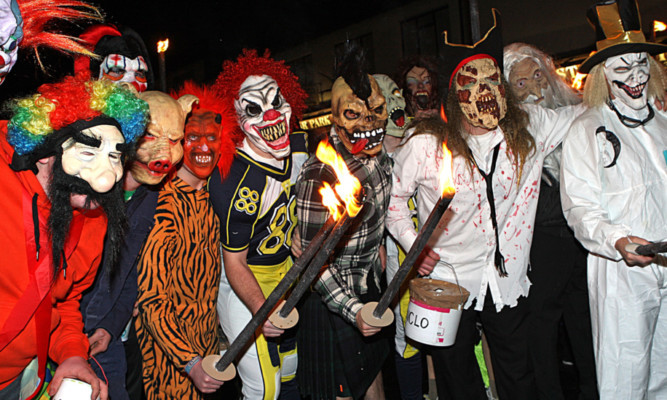Emerging from The Steeple, the procession makes its way east down Newburgh High Street.
At the front, a young man dressed in white robes is seated backwards on a Clydesdale horse, his identity and indeed his direction concealed by Halloween-style masks on the front and back of his head.
Like a scene from the Wicker Man movie, he is flanked by sinister-looking torchbearers and robe-wearing flag carriers.
Then from behind emerges the surreal site of a man dressed as an Egyptian Mummy, skipping down the road with a man in a gorilla suit.
They are followed by several men wearing wolf-style masks shaking collection tins, followed by further cloaked figures carrying flaming torches and staffs, some wearing university-style mortar boards.
Welcome to the Newburgh Caledonian Lodge of Oddfellows’ annual torchlit procession the only Hogmanay event of its type in Scotland, with roots dating back to the 19th century.
By tradition, the parade is headed by the newest apprentice, who always sits on a horse facing backwards – and without a saddle.
He is led by the Oddfellows’ Outside Guard, traditionally wearing a ‘Coat of Many Colours’. As well as a host of colourful characters in fancy dress, the parade includes a brass band.
Newburgh born-and-bred retired electrician and Oddfellows treasurer Gordon Pitkethly says the procession was deliberately designed to be entertaining and controversial with local causes at heart.
“The Oddfellows started off as a friendly society and was founded in 1827 by visitors from Dundee, who came up the River Tay on the paddle steamer for their holidays,”explains Gordon, 77, who joined when he was 17.
“There were two lodges in Dundee at that time and we were chartered from that at a time when there was no welfare state to support people. The name Oddfellows originally came about to describe those who didn’t have a trade.”
Despite the secretive nature of Oddfellow guilds in medieval times and legendary roots said to reach back to Biblical times, Gordon said the Newburgh group is not associated with any other lodge, organisation or religious groups and is now the only Oddfellow Lodge in existence in Scotland.
Set up as a friendly society, 19th century members paid a subscription every month or quarter, which entitled them to benefits. They were the working man’s means of providing security for himself and his family. In return for a regular subscription they provided insurance, sickness benefits, pensions and even burial grants.
The stated aim of the society was ‘the relief of its members in sickness and old age and for assisting at the expenses incurred at funerals’.
In the 19th century, Newburgh and its population of around 2000 was thriving through agriculture, textile, salmon and later linoleum.
Mutual aid organisations brought security to the inhabitants and the social life of the burgh for much of the 1800s.
But as welfare reform took its first tentative steps in the late Victorian era, and as the welfare state was later set up in the 20th century, many of the mutual aid societies folded.
Gordon said the Newburgh Oddfellows decided to continue as an annual fundraising torchlight procession for the community, with the first held in 1885.
Apart from going into abeyance during the first and second world wars and then for a period of 13 years due to lack of interest after the second world war, the event has gone ahead over the years in all weathers. It has also been held to mark coronations and to mark the millennium.
Members now meet from October to January each year to organise the Hogmanay procession and to decide upon the distribution of funds.
A street collection last year raised around £1300 with cheques going to Age Concern, the Old Folks’ Treat and Newburgh pensioners.
But ask Gordon why some of the more unusual aspects happen and he replies: “I have no idea why! It’s meant to be entertaining and it’s certainly that.
“The torchlit nature of the parade is a bit like the Up-Helly-Aa Viking festival, which aimed to drive the old spirits out .The torchlight nature of the Oddfellows Parade probably has similar influences, dating back to pagan times. But like many of these things, a lot of the reasons for the traditions are forgotten.”
The parade gets under way on Hogmanay at 7pm, midway along the High Street, near the Steeple, with the road closed to traffic for about an hour.
And the advice given to this year’s participants? To dress odd, and the odder the better! It’s certainly a spectacle to behold!
